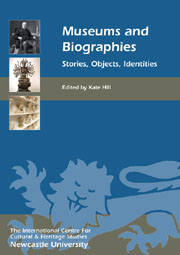Book contents
- Frontmatter
- Contents
- List of Illustrations
- Introduction: Museums and Biographies – Telling Stories about People, Things and Relationships
- INDIVIDUAL BIOGRAPHY AND MUSEUM HISTORY
- PROBLEMATISING INDIVIDUALS' BIOGRAPHIES
- INSTITUTIONAL BIOGRAPHIES
- OBJECT BIOGRAPHIES
- 12 Classifying China: Shifting Interpretations of Buddhist Bronzes in Liverpool Museum, 1867–1997
- 13 ‘Dressed like an Amazon’: The Transatlantic Trajectory of a Red Feather Coat
- 14 Individual, Collective and Institutional Biographies: The Beasley Collection of Pacific Artefacts
- 15 Sculptural Biographies in an Anthropological Collection: Mrs Milward's Indian ‘Types’
- MUSEUMS AS BIOGRAPHY
- MUSEUMS AS AUTOBIOGRAPHY
- Endpiece: The Homunculus and the Pantograph, or Narcissus at the Met
- List of Contributors
- Index
14 - Individual, Collective and Institutional Biographies: The Beasley Collection of Pacific Artefacts
from OBJECT BIOGRAPHIES
Published online by Cambridge University Press: 05 February 2013
- Frontmatter
- Contents
- List of Illustrations
- Introduction: Museums and Biographies – Telling Stories about People, Things and Relationships
- INDIVIDUAL BIOGRAPHY AND MUSEUM HISTORY
- PROBLEMATISING INDIVIDUALS' BIOGRAPHIES
- INSTITUTIONAL BIOGRAPHIES
- OBJECT BIOGRAPHIES
- 12 Classifying China: Shifting Interpretations of Buddhist Bronzes in Liverpool Museum, 1867–1997
- 13 ‘Dressed like an Amazon’: The Transatlantic Trajectory of a Red Feather Coat
- 14 Individual, Collective and Institutional Biographies: The Beasley Collection of Pacific Artefacts
- 15 Sculptural Biographies in an Anthropological Collection: Mrs Milward's Indian ‘Types’
- MUSEUMS AS BIOGRAPHY
- MUSEUMS AS AUTOBIOGRAPHY
- Endpiece: The Homunculus and the Pantograph, or Narcissus at the Met
- List of Contributors
- Index
Summary
Ethnographic collections housed in museums are, in theory, no different from any other collections of arts or crafts. They are made of objects assembled by a collector with a particular motive, in a particular historical and cultural context. In practice, however, ethnographic collections tell a very different story.
From the outset, collecting from the Pacific was the by-product of a scientific project of discovery and encounters. Although some ethnographic objects had been displayed in wunderkammer and cabinets of curiosities in the Renaissance period, it was James Cook' three voyages of exploration (1768–71, 1772–75 and 1776–79) that revealed the Pacific to Britain. It was not until the middle of the 19th century, however, that these ‘artificial curiosities’ (Kaeppler 1978; Thomas 1994) became objects of scientific enquiry. The development of ethnology, ethnography and anthropology in the late 19th century placed ‘exotic’ material at the centre of a broader field of scientific enquiry aimed at unlocking the mysteries and diversity of mankind. This shift in the perception of ethnographic objects triggered a new attitude within academia and museums. Because each new piece of material culture could contribute to a better understanding of foreign lands and peoples – and by extension, of our lands and peoples – collecting artefacts from the cultures of Oceania, Africa or North America became a scientific priority (Gowland 1904, 13–14).
- Type
- Chapter
- Information
- Museums and BiographiesStories, Objects, Identities, pp. 201 - 214Publisher: Boydell & BrewerPrint publication year: 2012



